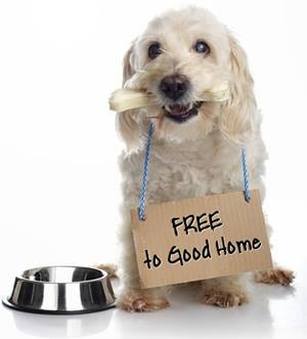Free to Good Home? Danger.

Most of the time unwanted pets should be taken to an animal shelter or a legitimate rescue group. Most often only Shelters and Rescue Groups are qualified to screen potential adopters of animals. Their adoption requirements provide safety for the animal. Animal Shelters provide important and necessary public services throughout the United States. These shelters and the people who care for the animals are the first line of rescue for abandoned, homeless, abused and neglected animals. Animals are always better off going to a legitimate animal shelter than being handed over to a stranger or a poorly run or fake rescue group.
There are many dangers for stolen, lost, and unwanted pets. They can be:
Used for dog fight training
Sold to research laboratories
Tortured for fun
Sold at auctions
Skinned for their fur
Eaten by humans
Fed to captive carnivores like tigers or reptiles
The dog, cat or other animal considers the original pet guardian his or her family. If she is being treated well she will be unhappy and homesick when given away to strangers. It's the responsibility of the pet's guardian to ensure the transition is smooth and that the new family will provide a safe and loving home. The pet is totally dependent on the pet owner for his or her protection. Consider the animal's feelings.
If the pet's owner refuses to take the unwanted pet to a Shelter or legitimate Rescue Group then for the safety of the pet the following adoption process should be followed:
1) Pet must be spayed or neutered and have a rabies shot before making him or her available for adoption. A reasonable adoption fee should be required.
2) Those interested in the animal must agree to a home visit before the animal is adopted. Visit the home without the pet along to determine whether your pet will be safe and happy.
3) Adopter must have a fenced in yard for dogs. No chaining; no keeping dogs in a small pen; and no closed crating to be used as the primary method of keeping the dog inside.
4) Cats who have lived indoors should not be adopted out to homes where they will be immediately put outdoors especially in the winter.
5) Cats and dogs should be kept on their own property at all times. If cats are allowed to roam the cat must be confined on the property the first three weeks so the cat will learn to accept his or her new home. Recently adopted cats and dogs both can disappear as they seek to find their way back to their original homes and families.
6) The adopter must provide two references who are not relatives and the name of their vet if they have one.
7) The adopter must agree to a home visit prior to adoption and two follow up visits after adoption.
8) The adopter must agree to return the animal to the original family or individual if the adopter no longer wants the pet.
9) The adopter must sign an adoption contract in front of a Notary agreeing to all adoption requirements.
10) The original pet owner should run a criminal background check on the adopter and contact local animal control to determine if the person has had problems with animals.
11) The original owner should microchip the pet and include a collar identifying the new owner.
12) The original owner must do two follow up visits to the home to ensure the pet is doing well.
13) If the pet owner and pet adopter will not perform all of the above adoption requirements then the pet should be taken to an animal shelter or legitimate rescue.
Please don't hand animals over to strangers.